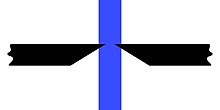Side cutter
A side cutter is a pair of pliers for cutting, i.e. separating by wedge cutting . The name is derived from the arrangement of the cutting edges , which, in contrast to the center cutter, are not located in the middle, but on the sides of the cutting jaws. The cutting edges are aligned with one of the two sides of the facing jaws. This arrangement has the advantage that, for. B. a protruding from a surface wire can be cut off flush. In contrast to the center cutter, the interface can be defined better because the vertical view of it is not blocked by the jaws. The disadvantage is the greater cutting force required due to the asymmetry of the cutting edges than with the center cutter with symmetrical cutting edges.
The side cutter is used in particular in electrical installations to cut individual wires or entire cables . High strength wires can also be cut due to the law of leverage if they are placed as close as possible to the joint of the pliers. There are so-called power side cutters on the market , in which this approximation is improved by a special design of the joint.
Some side cutters, like bolt cutters, are equipped with a second pair of levers compared to the simple pair of levers. The cutting force is increased without the pliers being significantly lengthened as a result of longer hand movements. As with bolt cutters, however, the handles are wider open at the beginning, which requires two-handed operation.
See also
Web links
- Pliers knowledge on the Knipex website

